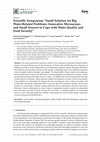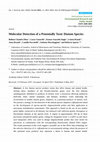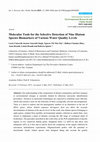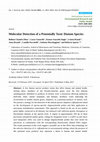Papers by Lucia Cimarelli

This issue presents the conclusive results of two European Commission funded Projects, namely Uni... more This issue presents the conclusive results of two European Commission funded Projects, namely Universal Microarrays for the Evaluation of Fresh-water Quality Based on Detection of
Pathogens and their Toxins (MicroAQUA) and Rationally Designed Aquatic Receptors (RADAR).
These projects focused their activities on the quality of drinking water as an extremely important factor for public health of humans and animals. The MicroAQUA Project aimed at developing a universal microarray chip for the detection of various pathogens (cyanobacteria, bacteria, viruses and parasitic protozoa) and their toxins in waters. In addition, the project included the detection of select species of diatoms, which represent reliable bio-indicators to assess overall water quality.
Large numbers of compounds are released into the environment; some of these are toxins such as endocrine disrupting compounds (EDCs) and can affect the endocrine, immune and nervous systems of a wide range of animals causing alterations such as reproductive disorders and cancer.
Detection of these contaminants in water systems is important to protect sensitive environmental sites and reduce the risk of toxins entering the food chain. A modular platform for monitoring toxins in water and food production facilities, using biosensors derived from aquatic organisms, was the main goal of RADAR Project.

Abstract: A few diatom species produce toxins that affect human and animal health. Among these, m... more Abstract: A few diatom species produce toxins that affect human and animal health. Among these, members of the Pseudo-nitzschia genus were the first diatoms unambiguously identified as producer of domoic acid, a neurotoxin affecting molluscan
shell-fish, birds, marine mammals, and humans. Evidence exists indicating the involvement of another diatom genus, Amphora, as a potential producer of domoic acid. We present a strategy for the detection of the diatom species Amphora coffeaeformis based
on the development of species-specific oligonucleotide probes and their application in microarray hybridization experiments. This approach is based on the use of two marker
genes highly conserved in all diatoms, but endowed with sufficient genetic divergence to discriminate diatoms at the species level. A region of approximately 450 bp of these previously unexplored marker genes, coding for elongation factor 1-a (eEF1-a) and silicic
acid transporter (SIT), was used to design oligonucleotide probes that were tested for specificity in combination with the corresponding fluorescently labeled DNA targets.
The results presented in this work suggest a possible use of this DNA chip technology for the selective detection of A. coffeaeformis in environmental settings where the presence of
this potential toxin producer may represent a threat to human and animal health. In addition, the same basic approach can be adapted to a wider range of diatoms for the simultaneous detection of microorganisms used as biomarkers of different water quality levels.

Our understanding of the composition of diatom communities and their response to environmental ch... more Our understanding of the composition of diatom communities and their response to environmental changes is currently limited by laborious taxonomic identification procedures. Advances in molecular technologies are expected to contribute more efficient, robust and sensitive tools for the detection of these ecologically relevant microorganisms.
There is a need to explore and test phylogenetic markers as an alternative to the use of rRNA genes, whose limited sequence divergence does not allow the accurate discrimination of diatoms at the species level. In this work, nine diatom species belonging to eight genera, isolated from epylithic environmental samples collected in central Italy, were chosen to implement a panel of diatoms covering the full range of ecological status of freshwaters. The procedure described in this work relies on the PCR amplification of specific regions in two conserved diatom genes, elongation factor 1-a (eEF1-a) and silicic acid transporter (SIT), as a first step to narrow down the complexity of the targets, followed by microarray hybridization experiments. Oligonucleotide probes with the potential to discriminate closely related species were designed taking into account the genetic
polymorphisms found in target genes. These probes were tested, refined and validated on a small-scale prototype DNA chip. Overall, we obtained 17 highly specific probes targeting
eEF1-a and SIT, along with 19 probes having lower discriminatory power recognizing at the same time two or three species. This basic array was validated in a laboratory setting and is ready for tests with crude environmental samples eventually to be scaled-up to include a larger panel of diatoms. Its possible use for the simultaneous detection of diatoms selected from the classes of water quality identified by the European Water Framework Directive is discussed.

A few diatom species produce toxins that affect human and animal health. Among these, members of ... more A few diatom species produce toxins that affect human and animal health. Among these, members of the Pseudo-nitzschia genus were the first diatoms unambiguously identified as producer of domoic acid, a neurotoxin affecting molluscan shell-fish, birds, marine mammals, and humans. Evidence exists indicating the involvement of another diatom genus, Amphora, as a potential producer of domoic acid.
We present a strategy for the detection of the diatom species Amphora coffeaeformis based on the development of species-specific oligonucleotide probes and their application in microarray hybridization experiments. This approach is based on the use of two marker genes highly conserved in all diatoms, but endowed with sufficient genetic divergence to
discriminate diatoms at the species level. A region of approximately 450 bp of these previously unexplored marker genes, coding for elongation factor 1-a (eEF1-a) and silicic
acid transporter (SIT), was used to design oligonucleotide probes that were tested for specificity in combination with the corresponding fluorescently labeled DNA targets.
The results presented in this work suggest a possible use of this DNA chip technology for the selective detection of A. coffeaeformis in environmental settings where the presence of this potential toxin producer may represent a threat to human and animal health.
In addition, the same basic approach can be adapted to a wider range of diatoms for the simultaneous detection of microorganisms used as biomarkers of different water quality levels.
Uploads
Papers by Lucia Cimarelli
Pathogens and their Toxins (MicroAQUA) and Rationally Designed Aquatic Receptors (RADAR).
These projects focused their activities on the quality of drinking water as an extremely important factor for public health of humans and animals. The MicroAQUA Project aimed at developing a universal microarray chip for the detection of various pathogens (cyanobacteria, bacteria, viruses and parasitic protozoa) and their toxins in waters. In addition, the project included the detection of select species of diatoms, which represent reliable bio-indicators to assess overall water quality.
Large numbers of compounds are released into the environment; some of these are toxins such as endocrine disrupting compounds (EDCs) and can affect the endocrine, immune and nervous systems of a wide range of animals causing alterations such as reproductive disorders and cancer.
Detection of these contaminants in water systems is important to protect sensitive environmental sites and reduce the risk of toxins entering the food chain. A modular platform for monitoring toxins in water and food production facilities, using biosensors derived from aquatic organisms, was the main goal of RADAR Project.
shell-fish, birds, marine mammals, and humans. Evidence exists indicating the involvement of another diatom genus, Amphora, as a potential producer of domoic acid. We present a strategy for the detection of the diatom species Amphora coffeaeformis based
on the development of species-specific oligonucleotide probes and their application in microarray hybridization experiments. This approach is based on the use of two marker
genes highly conserved in all diatoms, but endowed with sufficient genetic divergence to discriminate diatoms at the species level. A region of approximately 450 bp of these previously unexplored marker genes, coding for elongation factor 1-a (eEF1-a) and silicic
acid transporter (SIT), was used to design oligonucleotide probes that were tested for specificity in combination with the corresponding fluorescently labeled DNA targets.
The results presented in this work suggest a possible use of this DNA chip technology for the selective detection of A. coffeaeformis in environmental settings where the presence of
this potential toxin producer may represent a threat to human and animal health. In addition, the same basic approach can be adapted to a wider range of diatoms for the simultaneous detection of microorganisms used as biomarkers of different water quality levels.
There is a need to explore and test phylogenetic markers as an alternative to the use of rRNA genes, whose limited sequence divergence does not allow the accurate discrimination of diatoms at the species level. In this work, nine diatom species belonging to eight genera, isolated from epylithic environmental samples collected in central Italy, were chosen to implement a panel of diatoms covering the full range of ecological status of freshwaters. The procedure described in this work relies on the PCR amplification of specific regions in two conserved diatom genes, elongation factor 1-a (eEF1-a) and silicic acid transporter (SIT), as a first step to narrow down the complexity of the targets, followed by microarray hybridization experiments. Oligonucleotide probes with the potential to discriminate closely related species were designed taking into account the genetic
polymorphisms found in target genes. These probes were tested, refined and validated on a small-scale prototype DNA chip. Overall, we obtained 17 highly specific probes targeting
eEF1-a and SIT, along with 19 probes having lower discriminatory power recognizing at the same time two or three species. This basic array was validated in a laboratory setting and is ready for tests with crude environmental samples eventually to be scaled-up to include a larger panel of diatoms. Its possible use for the simultaneous detection of diatoms selected from the classes of water quality identified by the European Water Framework Directive is discussed.
We present a strategy for the detection of the diatom species Amphora coffeaeformis based on the development of species-specific oligonucleotide probes and their application in microarray hybridization experiments. This approach is based on the use of two marker genes highly conserved in all diatoms, but endowed with sufficient genetic divergence to
discriminate diatoms at the species level. A region of approximately 450 bp of these previously unexplored marker genes, coding for elongation factor 1-a (eEF1-a) and silicic
acid transporter (SIT), was used to design oligonucleotide probes that were tested for specificity in combination with the corresponding fluorescently labeled DNA targets.
The results presented in this work suggest a possible use of this DNA chip technology for the selective detection of A. coffeaeformis in environmental settings where the presence of this potential toxin producer may represent a threat to human and animal health.
In addition, the same basic approach can be adapted to a wider range of diatoms for the simultaneous detection of microorganisms used as biomarkers of different water quality levels.
Pathogens and their Toxins (MicroAQUA) and Rationally Designed Aquatic Receptors (RADAR).
These projects focused their activities on the quality of drinking water as an extremely important factor for public health of humans and animals. The MicroAQUA Project aimed at developing a universal microarray chip for the detection of various pathogens (cyanobacteria, bacteria, viruses and parasitic protozoa) and their toxins in waters. In addition, the project included the detection of select species of diatoms, which represent reliable bio-indicators to assess overall water quality.
Large numbers of compounds are released into the environment; some of these are toxins such as endocrine disrupting compounds (EDCs) and can affect the endocrine, immune and nervous systems of a wide range of animals causing alterations such as reproductive disorders and cancer.
Detection of these contaminants in water systems is important to protect sensitive environmental sites and reduce the risk of toxins entering the food chain. A modular platform for monitoring toxins in water and food production facilities, using biosensors derived from aquatic organisms, was the main goal of RADAR Project.
shell-fish, birds, marine mammals, and humans. Evidence exists indicating the involvement of another diatom genus, Amphora, as a potential producer of domoic acid. We present a strategy for the detection of the diatom species Amphora coffeaeformis based
on the development of species-specific oligonucleotide probes and their application in microarray hybridization experiments. This approach is based on the use of two marker
genes highly conserved in all diatoms, but endowed with sufficient genetic divergence to discriminate diatoms at the species level. A region of approximately 450 bp of these previously unexplored marker genes, coding for elongation factor 1-a (eEF1-a) and silicic
acid transporter (SIT), was used to design oligonucleotide probes that were tested for specificity in combination with the corresponding fluorescently labeled DNA targets.
The results presented in this work suggest a possible use of this DNA chip technology for the selective detection of A. coffeaeformis in environmental settings where the presence of
this potential toxin producer may represent a threat to human and animal health. In addition, the same basic approach can be adapted to a wider range of diatoms for the simultaneous detection of microorganisms used as biomarkers of different water quality levels.
There is a need to explore and test phylogenetic markers as an alternative to the use of rRNA genes, whose limited sequence divergence does not allow the accurate discrimination of diatoms at the species level. In this work, nine diatom species belonging to eight genera, isolated from epylithic environmental samples collected in central Italy, were chosen to implement a panel of diatoms covering the full range of ecological status of freshwaters. The procedure described in this work relies on the PCR amplification of specific regions in two conserved diatom genes, elongation factor 1-a (eEF1-a) and silicic acid transporter (SIT), as a first step to narrow down the complexity of the targets, followed by microarray hybridization experiments. Oligonucleotide probes with the potential to discriminate closely related species were designed taking into account the genetic
polymorphisms found in target genes. These probes were tested, refined and validated on a small-scale prototype DNA chip. Overall, we obtained 17 highly specific probes targeting
eEF1-a and SIT, along with 19 probes having lower discriminatory power recognizing at the same time two or three species. This basic array was validated in a laboratory setting and is ready for tests with crude environmental samples eventually to be scaled-up to include a larger panel of diatoms. Its possible use for the simultaneous detection of diatoms selected from the classes of water quality identified by the European Water Framework Directive is discussed.
We present a strategy for the detection of the diatom species Amphora coffeaeformis based on the development of species-specific oligonucleotide probes and their application in microarray hybridization experiments. This approach is based on the use of two marker genes highly conserved in all diatoms, but endowed with sufficient genetic divergence to
discriminate diatoms at the species level. A region of approximately 450 bp of these previously unexplored marker genes, coding for elongation factor 1-a (eEF1-a) and silicic
acid transporter (SIT), was used to design oligonucleotide probes that were tested for specificity in combination with the corresponding fluorescently labeled DNA targets.
The results presented in this work suggest a possible use of this DNA chip technology for the selective detection of A. coffeaeformis in environmental settings where the presence of this potential toxin producer may represent a threat to human and animal health.
In addition, the same basic approach can be adapted to a wider range of diatoms for the simultaneous detection of microorganisms used as biomarkers of different water quality levels.